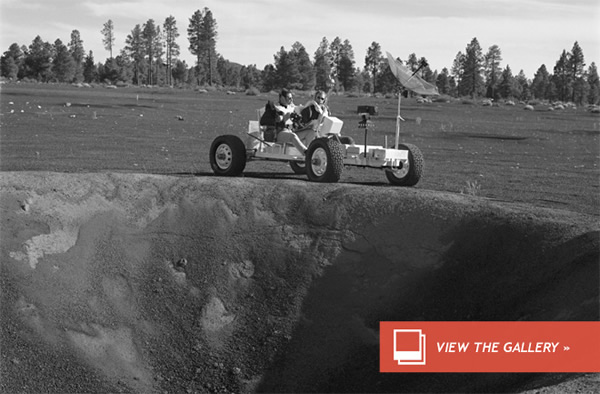When NASA Blew Holes In Arizona for Apollo
When NASA Blew Holes In Arizona for Apollo
NASA knew full well that the Apollo lunar landing missions were risky, and it took steps to minimize the chances of losing astronauts in space.
Redundancies were built into the spacecraft, and astronauts and technicians alike spent hours simulating missions. Mission planners also used simulations to anticipate as many aspects of a lunar mission as possible, going so far, in 1967, as recreating the moon in northern Arizona.
The Arizonian landscaping was part of the Astrogeology Research Program, a joint undertaking between NASA and the United States Geological Survey (USGS). Beginning in 1963, the idea was to give Apollo astronauts as realistic a training ground as possible for their eventual EVAs on the lunar surface.
The program’s main site was a place called Cinder Field, an area where basaltic cinders covered the natural clay landscape following the Sunset Volcanic Crater’s eruption around 1064. To make it more moon-like, NASA added craters to the site with dynamite. To make each crater, a site was excavated and filled with a mixture of dynamite and ammonium nitrates. After some test explosions, a necessary step to calibrate how much power was needed to make a crater of a certain size, the real blasting began.
The first phase of “construction” ran from July 28 to 31, 1967. Forty-seven craters were made over those four days, varying in depth between 5 and 40 feet in a 500 square foot area. The finished product was a full scale reproduction of an area at the Sea of Tranquility that NASA had settled on as a potential landing site for Apollo 11.
The site was expanded between Oct. 8 and 12 of that year. Ninety-six craters were added for a total of 143 in an 800 square foot field. In all, 312.5 pounds of dynamite and 13,492 pounds of a mixture of agricultural fertilizer and fuel oil were used in those first two phases of construction.
A second, larger field was eventually built after the first, also in an area where basaltic cinders were deposited on top the clay by the Sunset Volcanic Crater. This created a some realistic effects as the light colored clay was excavated in the blast, a feature the site’s creators used to their advantage. Several sets of explosions in sequence created craters with overlapping ejecta blankets to mimic different ages, just like exist on the moon.
The first round took 182 blasts and mimicked the oldest craters on the moon’s surface. A second blast added the intermediate age craters with 61 blasts. A final round to simulate the youngest lunar craters comprised 111 blasts. In all, it took 1,153 pounds of dynamite, 28,650 pounds of nitro-Carbo nitrate, and 40,000 feet of Primacord to build this second field.
With their faux moon in place, the astronauts moved in. A simulated Lunar Module was placed on top of a ramp to give them a preview of what they would see out the small triangular coming in for a landing over certain landmarks. They practiced using specially designed tools in their bulky spacesuits and deploying scientific experiments like ALSEP. It gave them a place to test lunar rovers, first the “Explorer” and then “Grover,” the Apollo prime and backup crews’ main training vehicle.
It was also a hands-on classroom. With the exception of Apollo 17’s Lunar Module Pilot Jack Schmitt, none of the Apollo astronauts was a trained geologist. They all had to learn to identify features, rock types, and most importantly they had to learn the right terminology so they could tell the scientists at NASA exactly what they were seeing up there. The Cinder Lake crater field gave them a chance to practice describing crater morphologies and the stratigraphic relationships of unconsolidated materials.
The real Sea of Tranquility on the moon hasn’t changed since Neil Armstrong and Buzz Aldrin left in 1969, but the man-made analogue didn’t survive. The site has been resurfaced by wind, rain, and people. It’s a shame, too. A virtual Sea of Tranquility would be a fantastic destination for space-nuts the world over.
Mar 4, 2013 12:25 PM ET by Amy Shira Teitel












